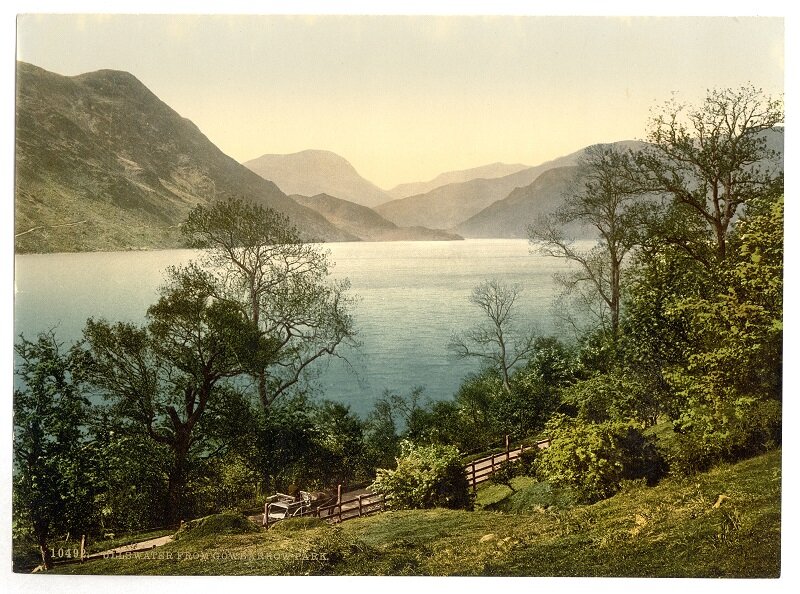Fell Ponies, Gowbarrow Park, and The National Trust
/I am elated that the Fell Pony Heritage Centre has recently arranged for Fell Ponies to return to Gowbarrow Park in the English Lake District. What follows is an excerpt from a longer article about Fell Ponies and Gowbarrow Park, first published in Fell Pony News from Willowtrail Farm, June 2019. The full article is available by clicking here.
J. Swinburn, Gowbarrow Hall, Watermillock in Reminiscences of Joe Bowman and the Ullswater Foxhounds by WC Skelton, 1921
Fell Ponies had been raised in Gowbarrow Park before the National Trust started its herd. John Swinburn of Gowbarrow Hall bred and registered ponies from 1894 to 1926. The first pony to appear in the stud books of the Fell Pony Society as bred by Mr. Swinburn is General Pride 641. The Fell Pony Museum has this text from General Pride’s stud card: “General Pride is a horse of class and character. His class of bone, hair, his legs, feet and pasterns, and his general appearance at once denote a breeding horse; in fact, he is admitted by competent judges to be a perfect model of the breed; and as regards his action, a single glance at the same will convince anyone that he is, without a doubt, the finest stepping pony in existence.” The card then lists the many accomplishments of General Pride’s near ancestors. (1) The stallion General Pride is found behind all modern day Fell Ponies. (2)
A mare Mr. Swinburn bred named Crow who was foaled in 1898 placed second for the Earl of Lonsdale in a Fell Pony mare class at Carlisle circa 1902. (3) Swinburn’s ponies were used to produce the Ullswater ponies at Knotts Farm. Watermillock-on-Ullswater in 1931.
It was in the 1940s that the National Trust had Fell Ponies in Gowbarrow Park. “The little herd of well-bred pedigree ponies… were presented to the Trust by the late Mr. Charlton (4) during the war. At that time the breed was facing destruction with very few purely-bred foals being born, and a large number of crossbred Fell-Clydesdale ponies being reared to work on small farms. The future of the breed was very uncertain, and it was hoped that the Trust would be able to preserve a small herd of pedigree ponies of the best type on Gowbarrow Park, by the shores of Ullswater, where there is ample ground, shelter and good grazing for a number of ponies.” (5)
In 1936, Bruce Thompson became the first land agent for the National Trust in the Lake District. He and his wife Mary raised Fell Ponies, “and they often rode out together to the Trust farms to collect the rent.” (6) According to Linda Lear in her book Beatrix Potter: A Life in Nature, Bruce Thompson served a term as President of the Fell Pony Society after the Second World War. (7) It is Mr. Thompson’s name that is associated with the first registrations of the National Trust’s ponies. In Volume XXIV, three ponies - Gowbarrow Lad, Lass, and Lightning - are registered, all foaled in 1943. They are all by Linnel Romany II and out of the Linnel mares Rosemary, Girl, and Flash, respectively, that were transferred to the National Trust in the same volume. The National Trust’s address in this volume is given as Troutbeck, Windermere.
In 1948 a second generation of the National Trust’s herd began with the birth of Gowbarrow Rover out of G. Mary and in 1949 with G. Laverock also out of Mary. The last Gowbarrow pony, Linnet, was foaled in 1949. By this time the National Trust address was Ambleside.
Many of the Gowbarrow ponies were absorbed by the McCosh family into the Dalemain herd. And then in 1950, “when the Fell breed was in a more healthy state, it was decided to dispose of the herd. The Trust offered what remained of the herd to the Fell Pony Society… The Fell Pony Society decided to accept the offer…. It was extremely disappointing to the Fell Pony Society that the Trust, with their vast areas of Lakeland, should dispose of their well-bred herd. Eventually it was decided to resell the ponies to members of the Fell Pony Society at the 1950 Colt Show….” (8) None of the Gowbarrow mare lines survive. (9) Today the Gowbarrow prefix is owned by Ruth Eastwood; no ponies have been registered under that prefix since the 1990s.
Ullswater from Gowbarrow Park. Courtesy Library of Congress (10)
I have now written a follow-on article about Fell Ponies near Gowbarrow Hall Farm. To request it, click here.
Using the tools of the Fell Pony Pedigree Information Service, a search for descendants of General Pride was conducted in the 2007 and 2017 foal crops. 100% of foals with pedigrees deep enough showed General Pride behind them.
Journal of the Royal Agricultural Society of England, Volume 63, Royal Agricultural Society of England, 1902 p. cix. As found on books.google.com.
This ‘late Mr. Charlton’ is not to be confused with our late Mr. Charlton. The Mr. Charlton referenced here would be our late Mr. Charlton’s grandfather.
Fell Pony Stud Book Registrations 1898-1980, The Fell Pony Society, circa 1981, p. 182.
Lear, Linda. Beatrix Potter: A Life in Nature. New York: St. Martin’s Griffin, 2007, p. 395.
Lear, p. 530, note #36.
Same as #5.
According to the tools of the Fell Pony Pedigree Information Service, no Gowbarrow ponies from Thompson or Swinburn’s breeding show up in pedigrees of the 2007 or 2017 foal crops.
4) Gowbarrow Park postcard from the Library of Congress at https://www.loc.gov/pictures/resource/ppmsc.08519/
I am grateful to Eddie McDonough for his previous research on the Gowbarrow Fell Ponies.
© Jenifer Morrissey, 2019 and 2020




